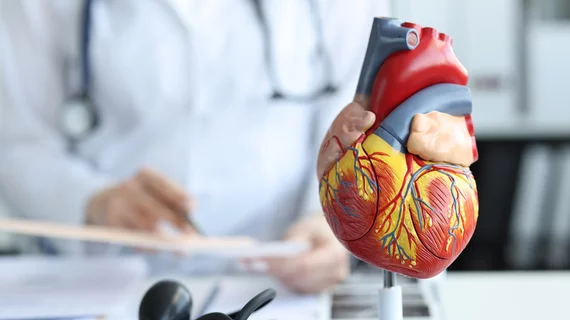Cardiac imaging use is skyrocketing, and radiologists are rising to the challenge
The use of cardiac imaging is skyrocketing in medicine, and radiologists appear to be rising to the challenge, according to new research published Wednesday.
Across 32 different countries, there was a 3.8-fold uptick in MR imaging for cardiac concerns between 2011 and 2022, experts detailed in European Radiology [1]. Same for CT of the heart, which saw a 4.5-fold increase during the same time span.
Reporting of such CT and MRI examinations was handled primarily by radiologists (at 71% and 76%, respectively) or in consensus with nonradiologists (19% and 27%). About 5% of CT and 2% of MRIs were reported by nonradiological specialties or in separate readings by rads/nonrads.
The data lend further credence to reports of surging imaging use in recent years, driven by mounting evidence of the modalities’ central role in diagnosis and guidance for cardiovascular disease.
“Real-life data on cardiac imaging in Europe…demonstrates a considerable increase in examinations over the past years, the vast majority of which are read by radiologists,” Federica Catapano, MD, a radiologist and researcher with Humanitas University in Milan, Italy, and colleagues wrote Feb. 28. “Our results suggest that radiologists have an increasingly important role to provide cardiac CT and MR imaging services, contributing to expanding availability and expertise in both academic and nonacademic centers.”
Catapano and co-authors gathered their information from the European Society of Cardiovascular Radiology’s MR-CT registry, altogether covering more than 432,000 exams. Over a decade, the number of annually submitted CT exams leapt 353%, up to 15,267 in 2022. Same for MRI, which climbed nearly 283%, to 13,183.
The main indications for cardiac CT were suspected coronary artery disease (59%) and transcatheter aortic valve replacement planning (59%). On the former, the number of patients with intermediate pretest probability who underwent CT for suspected CAD climbed from 61% in 2012 to 82% in 2022. Suspected myocarditis (26%), CAD (21%) and suspected cardiomyopathy (19%) were the primary reasons for cardiac MRI. Adverse events rates for both CT (0.3%) and MRI (0.7%) were low, underlining radiology’s safe use of these exams.
Overutilization likely played a part in the uptick, the authors noted. Catapano et al. see an important role for the specialty in pushing providers to use these diagnostic tools properly when assessing heart patients.
“Radiology acts as a crucial barrier against the overutilization of medical imaging, ensuring correct application of different modalities according to current recommendations and guidelines,” the authors concluded.
Read more at the link below.

